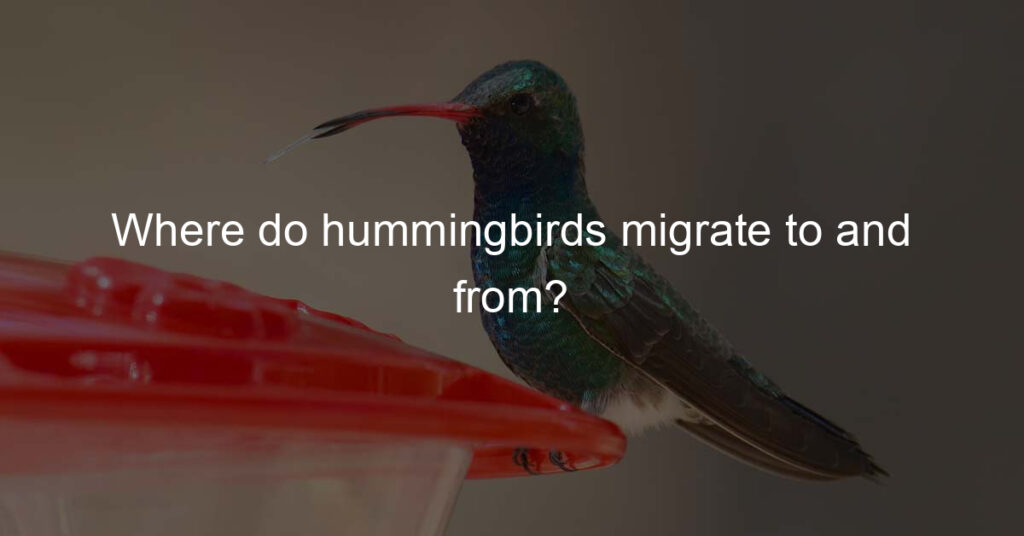Do you love hummingbirds? Do you want to know where they go when they migrate? Stay tuned to find out where these amazing creatures go and why!
Do Hummingbirds Migrate?
Hummingbirds are unique bird species that capture the awe and admiration of many, often with their intriguing display of aerial acrobatics. One notable behavior of these birds is migration, however, there is no set pattern for when and how hummingbirds migrate as it will vary from species to species.
In some areas, populations may remain stationary throughout the year while others will travel long distances when cooler weather approaches. Ornithologists agree that migration is an instinctive response in hummingbirds rather than a conscious decision like some other birds may make regarding when to depart for the season.
While migratory habits can be difficult to track, it is clear that certain species are extremely diligent in their travels and continue migrating even if any particular region has mild temperatures all year round. The true mystery of these fascinating creatures continues!
Where Do Hummingbirds Migrate in Winter?
Every winter, hummingbirds migrate to warmer climates in Central and South America. It’s an amazing sight to witness these tiny birds flying up to 2,000 miles south of their summer homes. Although we may not be able to go along for the ride, tracking technology has enabled scientists to better understand the incredible journey that hummingbirds take as they travel long distances through unfamiliar habitats.
Banding programs also help signal which populations are healthy and allow us to gain information about how these birds adjust their migration habits. By protecting habitat and providing food sources on their journeys, we can ensure that future generations of hummingbirds will continue to make this impressive yearly pilgrimage.
How long does it take hummingbirds to migrate?
Migrating hummingbirds can cover incredible distances and accomplish remarkable feats of endurance during their migration journey. Research shows that they can fly up to 500 miles in one flight and may take up to 20 days to make their way south.
To ensure successful navigation, these incredible birds use a variety of navigational tools, including landmarks, celestial cues, and even the Earth’s magnetic field. By relying on instinct along with these sophisticated methods of knowing where they are going, hummingbirds can cover thousands of miles in relative safety during their migratory travels each year.
How far can a hummingbird fly in one day?
A hummingbird’s ability to fly far in one day is impressive – some estimates suggest that they can fly up to 500 miles on a single day’s journey. While the birds’ small size may seem like a disadvantage, they make up for it with their remarkable agility and endurance while in flight, flapping their wings rapidly to propel themselves forward.
The birds are also incredibly light and have minimal drag due to the shape of their bodies, allowing them to move through the air with ease and cover great distances during their long-distance journeys. In doing so, these remarkable creatures have demonstrated that even the smallest of things can accomplish big things!
How far does a hummingbird fly per day during migration?
The incredible migration of the hummingbird is one of nature’s most awe-inspiring phenomena. These tiny birds are capable of flying thousands of miles in their journey across the continents, but just how far do they travel in a single day during their migration?
Remarkably, some experts believe hummingbirds can travel up to 800 miles per day. This means that over a three-month period, these extraordinary creatures could cover upwards of 12,000 to 13,000 miles! Such long-distance soaring shows just how hardy and determined these birds are – making them an excellent symbol of perseverance and resilience.
How long can hummingbirds fly without food?
Hummingbirds are known for their impressive abilities in both flight and speed; even able to defy gravity with a number of aerial tricks. But you may be surprised to learn that hummingbirds are also capable of soaring across the sky on virtually no fuel. In fact, some species can stay in flight for over two days, going without food and resting for extended periods of time.
This is achieved through feathered insulation—working as an effective temperature regulator–and likely having evolved from their ancient ancestors, who inhabited cooler climates in North America. A truly remarkable feat, and one which makes us question: just how high could these tiny birds fly?
Wrapping Up
While we often think of hummingbird migrations as one long journey, the truth is more complex. Most hummingbirds spend their summers breeding, and only some migrate to wintering areas. Of those who do, a few species migrate across the United States and even farther, to Central and South America. Others stick to shorter-range movements within the same country.
In either case, navigating their way through wide open skies without a map is an amazing feat for such small creatures! Watching the hummingbirds embark on their massive migration each year can be a beautiful reminder of how lucky we are to witness this incredible phenomenon from our backyards.
Hopefully, further research into these wondrous birds will continue to inform us about the movements of hummingbirds, so that we may better understand and appreciate these feathered friends throughout spring and summer.







